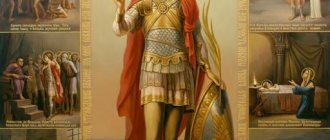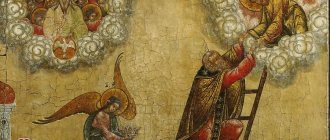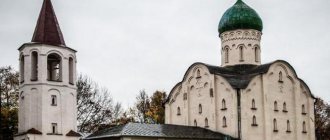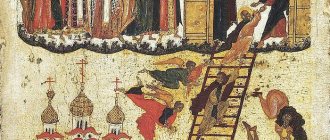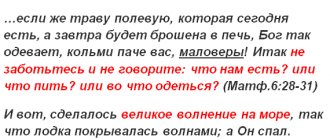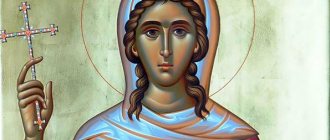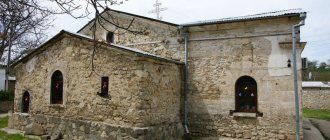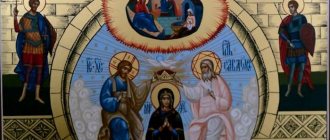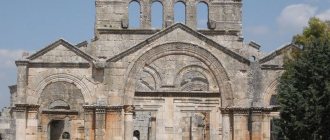Brief biography of the saint
Little is known about the life of the holy elder John Climacus. He was born in the 6th century. His biography is included in the “Tale of the Sinai Fathers”, authored by Anastasia Sinaita. Based on an ancient literary source, the year of birth of the elder is 579. Some sources indicate the year 525, but there is no exact confirmation.
The elder lived his entire life on Mount Sinai. The first life of the saint was compiled by the monk Daniel from the Raifa monastery, with whom John was friends during his lifetime. An unnamed contemporary and student of the hermit left memories of his mentor. Daniel included his notes in his essay.
Origin
The birthplace of John Climacus is Byzantium or Southern Palestine. According to legend, his parents are Saints Xenophon and Mary. They belonged to a noble class, but were distinguished by their kindness and piety. In their old age, the couple accepted monasticism and acquired the gift of clairvoyance.
If Xenophon and Mary are really the parents of John Climacus, the life would have mentioned his brother Arkady or his service in the Jerusalem monastery. But the monk spent his entire life in the desert. He had a brother, also a monk and abbot of the Sinai monastery. But the elder’s nameless contemporary calls him George. Therefore, the version about holy parents has not been proven.
From the old man’s writing style in the book “The Ladder” one can guess his education. Most likely, his ancestors were not commoners. Some historians believe that John Scholasticus and Climacus are one person. If you believe this statement, the monk had knowledge of rhetoric and law.
Life
In the footsteps of righteous parents or of his own free will, but at the age of 16 the young man went to live on Mount Sinai. For the first 4 years he became a novice under Elder Martyrius, and at the age of 20 he took monastic vows. On the day of his acceptance of monasticism, Elder Stratigios foresaw that John would serve for the good of the church and go down in the history of Orthodoxy.
For 19 years the monk was a student of Elder Martyrius. After the death of his mentor, John traveled to Egypt. He lived for a month among the monks of one of the Pachomiev monasteries and visited the Skete desert. Subsequently, in his instructive work, he portrayed the abbot of the Egyptian monastery as an exemplary shepherd.
Upon his return, Monk John went to live in a cave at the foot of Mount Sinai, in front of which lay the wasteland of Thola. He spent 40 years alone, fasting and praying. At that time, the hermit composed a saying about tears of repentance, which he cites in “The Ladder.” A tear of repentance washes away internal and external impurities, just as fire burns brushwood.
John Climacus led a moderately ascetic lifestyle. He did not exhaust himself by fasting, but ate food allowed during fasting as much as he needed. The Holy Father did not spend sleepless nights in prayer. He got enough sleep to keep his mind clear.
John was famous for his wisdom, and people often came to him for advice. The elder had a student, but his name is unknown. There were also ill-wishers. John was reproached for verbosity and vanity. To avoid temptation, he kept a vow of silence for a whole year. But his advice was greatly appreciated. Therefore, the people who reproached the elder themselves asked him to return to mentoring conversations.
At the age of 75, John, by invitation, headed the Sinai monastery and ruled the monastery for 4 years. Then he handed over the affairs to his brother George, again returned to solitude and lived in solitude until his death.
Miracles of the Reverend
Elder John greeted people who needed his guidance with warmth and understanding. The fame of the wise monk spread among church and ordinary people. The hermit was not proud of his miracles and sought solitude in a cave.
At the beginning of monasticism
John and the teacher Martyrius came to the Monk Anastasius the Sinoite. The great ascetic asked Martyrius who tonsured his student. He pointed to himself. Anastasius pointed in surprise at the new convert as the abbot of Mount Sinai. Another elder, John Savvait, in the presence of his disciple Stephen, washed the feet of young John, but not Martyrios. Stefan asked Savvait about this, and he replied that he washed the feet of the Sinai abbot, and not the youth.
In hermitage
A wonderful incident happened to his student. At the request of Father John, the monk worked in the garden on a hot day. At noon he was tired and lay down to rest. The elder was sitting in his cell. Suddenly the spirit of a venerable old ascetic appeared to Father John and said that his disciple was in danger. John began to pray for his disciple.
When the monk returned in the evening, the mentor asked him if his day had gone well. He replied that at noon he was taking a break from work and had a dream. John called his disciple in a dream. The monk woke up and wanted to run to help the teacher. But when he ran a little away from the resting place, a stone fell from the cliff there.
John helped brother Isaac get rid of the demon. Isaac came to the sage and told about the difficult struggle with the unclean. John called the unfortunate man to prayer. Before they had time to finish praying, the demon left Isaac and began to run away from his brothers, as if driven by an invisible whip. The saved monk thanked God and John, who glorified Him.
In old age
A miraculous phenomenon occurred when Father John became abbot of the monastery of St. Catherine in Sinai. The brothers really insisted that the wise hermit head their monastery, and he agreed, although he was already old. He was called the new Moses.
On the day of his ordination, among the six hundred guests in the monastery, a pilgrim in a rough toga with a short haircut was noticed. After the celebration he disappeared. None of the brothers knew him. Only Rev. John showed a miracle of foresight and realized that it was Mr. Moses who came to serve them in a holy place.
During a drought, local residents came to the abbot and asked him to help with a prayer for rain. After the saint’s prayer, moisture spilled onto the ground.
The most important miracle of John Climacus is humility, willpower and observation, thanks to which he himself was able to climb the ladder of piety and help others.
Death
The exact date of the death of Saint John Climacus is unknown. Presumably the year 649 is called. On the eve of his death, the monk gave his last instructions to the monks. In his last minutes, Father George was with him. His brother was sad that he was left alone to guard the monastery flock. He hoped to leave the earthly vale first, and that John would let him go. But the monk reassured George, promised to pray for him before God and predicted his death in less than a year. His prediction came true - his brother died 10 months later.
Creative heritage
The main work written by Elder John is “The Ladder.” The book is also known under the names “Spiritual Tablets”, “Ladder of Paradise”. It was written in the 6th century and reflects the way of monastic life of that time.
In the work, the author describes 30 stages of spiritual development corresponding to the years of Christ. A person who has overcome all the steps of the spiritual ladder will save his soul and enter the Kingdom of God. After ascending to the last step, a person will become equal to Jesus in purity of soul. But the elder called renunciation of worldly life the main condition for achieving spiritual perfection.
The monk wrote an essay for the instruction of the monks at the request of the Raifa abbot. He heard about the exploits, wisdom and fortitude of Elder John and wanted other monks to learn piety and humility. But “The Ladder” is useful reading not only for clergy. Lay people will also find useful instructions in the book. The main teaching of the author is that for the sake of salvation one must work selflessly, get rid of vices and passions and strive for the image of God. The structure of the book is similar to Jacob's ladder described in the Bible.
Saint John gives examples of zealous pursuit of piety. The book is based on his own spiritual research and observations. The monk teaches how to come to truth, love and spiritual purity, based on his own experience. Less known is the second literary work of Father John Climacus - the book “To the Shepherd”. In the essay, the monk addresses spiritual mentors and reports on their responsibilities.
Works of St. John Climacus
Contents and meaning of “The Ladder”
The book "The Ladder" is suitable for monks and lay people. The Holy Fathers Sergius of Radonezh and Joseph of Volokolamsk called this work the best aid in saving one’s own soul.
The work contains 30 chapters. Summary:
- Chapters 1–4: description of the fight against worldly vanity;
- Chapters 5–7: indication of sorrows during spiritual struggle;
- Chapter 8–17: the way to combat passions;
- Chapters 18–26: the obstacles that arise for any monk on the path of an ascetic are noted;
- Chapter 27–29: description of the spiritual world;
- Chapter 30: states 3 main virtues: faith, hope and love.
Advising the monastics, the monk noted 3 reasons why one can take monastic vows:
- love for the Lord;
- awareness of one's own sinfulness;
- desire for salvation and the inheritance of eternal life.
If you come to the monastery out of vanity, then this path will lead to fiery hell. Before embarking on hermitage or silence, you need to live the life of a monk in a monastery.
This work is considered a kind of ladder along which a person gradually ascends to the Heavenly Jerusalem, cutting off passions, constantly being in labor and struggle for his immortal soul. The purpose of the “Ladder” is to show people that in order to achieve eternal life they need to make efforts, show dedication, and begin feats.
The book "The Ladder" is suitable for monks and lay people
Ascetic lessons
The instructions on the asceticism of St. John have been preserved to this day. In particular, they are placed in volume II of the book “Philokalia”. This is a valuable guide for those who want salvation, allowing them to stick to the saving path without deviating into vanity and other passions dangerous to the soul. Every monk and layman must reveal to his spiritual father what he reads and what effect what he read has on him. Unauthorized reading of teachings and attempts at self-salvation without spiritual guidance are dangerous.
Iconography
John Climacus was depicted in two ways:
- portrait icon;
- on illustrations based on the plot of “The Ladder”.
The individual facial features of the elder are visible in the portraits:
- ascetic angularity;
- wrinkles on the forehead;
- long wide beard;
- receding hairline
Holy Father's Robe:
- chiton;
- mantle;
- schema with doll;
- Analav.
He is depicted with a book, scroll or cross in his hands.
Icons of John Climacus have been painted since the 10th century. Portraits of the elder are found on frescoes and pages of manuscripts. On the walls of Greek monasteries, mosaics have been preserved, in which the Holy Father is adjacent to the Monk Macarius of Egypt. The image of John Climacus is included in the cathedral icons “Holy Fathers of Sinai”, “Saints John Climacus, George and Blaise of Sebaste”. Images of the pious monk are found in churches in Serbia, Mount Athos, and Macedonia.
The saint can be found in painting systems and on frescoes in Russian churches: in Veliky Novgorod, Pskov, Moscow, Rostov, Pereslavl-Zalessky.
In the manuscripts of The Staircase, the author was depicted at the foot or at the top of the stairs. An illustration of an old man writing a book at a table was placed before the text. Sometimes he was depicted preaching to a crowd of brother monks. A manuscript with an illustration depicting John Climacus and Jesus Christ was kept in the Sinai monastery. In the miniature, the monk hands his book to the Savior. The icon of the saint at the top of the stairs was painted in Byzantium in the 12th century. In the iconographic image, next to the monk is Christ in the cloud segment and bestows blessing on him.
Akathist to St. John Climacus
Troparion
With your tears you cultivated the barren desert, and you brought forth fruit from the depths with sighs of a hundred labors, and you were a lamp of the universe, shining miracles, John Our Father, pray to Christ God, that our souls may be saved.
Kontakion
The ever-blooming fruits from your book, bringing teachings to wisdom, delight the hearts of those who listen with sobriety to the blessed: for there is a ladder of souls leading from the earth to the heavenly and abiding glory, who honor you by faith.
The Monk John Climacus showed people the path leading to eternal life through his personal example, unceasing labors, humility and meekness. In addition to the ascetic’s biography, which strengthens believers, his works have been preserved, recognized by the holy fathers as valuable in the matter of salvation. The main idea of the saint’s instruction is the need to make efforts and work on oneself, fighting passions and vices, which repeats the word Save.
If you find an error, please select a piece of text and press Ctrl+Enter.
Hymnography
In the 9th-11th centuries, the memory of the holy father was celebrated on March 30 without a festive service. From the second half of the 11th century, the canon, stichera and sedala were read to the saint. In Byzantium, a canon was written for the monk with an acrostic poem based on the plot of “The Ladder.”
According to the early Jerusalem Rule, on the memorial days of the saint, they also dispensed with festive hymns. In the 16th century, it was necessary to read the troparion and kontakion. In ancient Russian typikons it was prescribed to read hymns of dismissal on the day of remembrance and follow-up for Lent. Serbian Romanov Typik leads the festive sequence.
In modern services, the troparion of dismissal, kontakion 1 and 4 voices, irmos, and canons are read to the saint. The canon “Having kindly turned away from the world below” consists of 30 kontakia, includes irmos and theotokos, the meaning of which echoes the chapters of the “Ladder”. A non-sedal hymn or akathist, as well as a prayer, were not composed for the monk.
Veneration in Orthodoxy
The clergy venerate Saint John of the Climacus for his contribution to the improvement of the monastic way of life.
The “Ladder” of St. John was read during meals in monasteries. It was prescribed to be read during Lent five days a week. Translations of the book into ancient Christian languages have been preserved: Georgian, Armenian, Syriac, Slavic and Latin.
The eldest son of Ivan the Terrible was named in honor of the saint. After the birth of Tsarevich John, a dimensional icon of the patron saint was painted. The sons of Tsar John IV perpetuated the memory of the holy father in the churches of the Moscow Kremlin and the Belozersky Kirill Monastery built and consecrated in his honor.
Signs and sayings
- If a dandelion blooms on Ivan Climacus, it means that summer will quickly end.
- The birch already has foliage, but the alder does not yet - we need to prepare for a dry summer.
- The cherry blossoms have bloomed - the time has come to sow corn and beets.
- If the horse drinks a lot of water, it will rain soon, and if it hardly touches it, then the next few days will be clear.
- If bird nests are located more on the south side, then the summer will be cold.
- Wild geese fly high, which means spring and summer will be rainy.
- After winter, bees begin to fly out of the hive, which means that the weather will be good in the coming days.
- Those born on April 12th should wear Amazonite.
What do they ask for before the image?
John Climacus is a mentor for improving the spirit. Practical answers to requests for strengthening the spirit and help in the fight against vices that may be addressed to him will be found in his “Ladder.” With his writing he helps to overcome passions, cleanse the soul of sins with tears and repentance, and find peace and humility. In fear, sorrow, or discouragement, Christians can turn to the Ladder.
In front of the icon they glorify the saint on the day of remembrance and ask for strengthening in the faith. There was no special prayer to the monk. His feat consists of spiritual work. Therefore, they turn to the elder in their own words, after reading a hymn of praise.
Traditions and rituals
The main traditions on April 12 are baking small bread in the shape of a ladder; keep pets indoors and do not go out into the yard so that the brownie does not cause harm.
- Ritual cookies (bread) - ladders - were baked for Ivan the Climacus. They rolled two “sausages” out of the dough, placed them parallel to each other, and placed pies on top instead of steps. The number of steps in it had to be equal to the family members. Everyone had to eat these cookies - then they would have enough health for a whole year. Also, according to custom, these cookies were brought to church, where they were sprinkled with holy water.
— On April 12, the healers charmed the artists into vocation and glory. The young couple should not have visited their parents’ house that day - a quarrel could not be avoided. If the meeting could not be postponed, it was necessary to schedule it for the evening.
“According to legend, on this day the brownie behaves mischievously.” Angry at everyone, he torments the owners, destroys everything in the house, beats and chases horses, spoils cows - he wants away from food, teases dogs, throws utensils - sleighs and carts - around the yard, throws himself at the owners' feet so that they stumble. The brownie rages from early morning until midnight, and even until the next morning until the roosters crow.
- They explain this by saying that he is changing his old skin, or that he is having a wedding with a witch. In general, a brownie is a good owner. The rest of the time he helps with the housework and warns of trouble or imminent death. But his character is capricious. On April 12, it is better not to show your face to him. You can try to appease him, but the brownie will not completely calm down until the next morning. To avoid trouble, it is customary to lock up domestic animals and not go out into the yard yourself, not even going near the windows.
